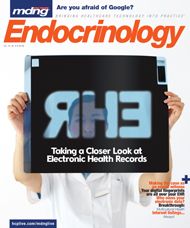Publication
Article
MDNG Endocrinology
Tech Sectors: Medical Devices: It's Time to Shed New Light on the Diabetes Epidemic
Author(s):
David Van Avermaete, CEO of VeraLight, a medical device company, discusses the SCOUT DS non-invasive diabetes screening system and the importance of early detection in type 2 diabetes.
A number of large studies have shown that if you can identify patients at risk for diabetes early enough, there’s a good chance that the disease can be at least delayed and possibly prevented with something as simple as diet, exercise intervention, or medication. Having said that, finding people early in the disease is not as easy as it sounds. There are two methods today that are approved and reimbursed for diabetes screening. The oral glucose tolerance test, which is the gold standard, is a two-hour lab procedure, so it’s almost never done unless the doctor suspects gestational diabetes. The other test is the fasting plasma glucose test, which is inconvenient for the patient because it requires fasting. In the middle of all that is our product, SCOUT DS. It’s a non-invasive diabetes type 2 and pre-diabetes screening device that uses a harmless source of fluorescent light shined into the underside of the arm to detect diabetes, producing results in less than a minute. Also, it doesn’t require the patient to fast. In our early clinical trials, we’ve found 30% more people than the other tests. Basically, our product is an easy-to-administer, one-minute, non-fasting, non-invasive test that is more sensitive than the existing alternatives. This enables opportunistic screening, which allows us to screen more people, fi nd more disease, intervene earlier, and prevent more diabetes.
What are you measuring when you shine the fluorescent light through someone’s arm?
We measure advanced glycated end products (AGEs). Everybody accumulates AGEs over time, but people who have diabetes accumulate them much faster. It turns out that these AGEs fluoresce in your skin. The best example is pentosidine, which is a part of glycated collagen. As you eat food, some of the blood glucose hooks onto collagen, which has a very slow half-life. Glycated collagen turns over about every 15 years, so it’s a much more stable metric of glycemic results. It’s not the kind of test that you manage diabetes with, but it is a great test for screening for diabetes. We quantitate these glycated proteins in people’s skin and then we adjust those for age. Th en we use that to accurately and sensitively classify people as either pre-diabetic, undiagnosed type 2s, or normal.
What were some of the biggest challenges you faced during the SCOUT development process? \Although it sounds pretty simple—you shine a light into the arm, it glows, and you measure it—it’s not so easy to extract the data. You have to screen out the “noise” associated with the diff erent colors and textures of skin. In recent trials, we’ve measured up to 7,000 people of diff erent sizes, shapes, ages, and racial and cultural backgrounds to make sure the modeling that we’re doing is applicable to a wide population. Administering a trial of that size is diffi cult for a small company. Th e FDA is evaluating our PMA [Premarket Approval] application, which is the most stringent type of device marketing application required by the FDA. That’s been challenging for us because what we’re doing is so novel that there’s no predicate.
Where are you in the approval process, and where do you hope to be in a year? We’re working on a two-part pivotal trial, the first phase of which is a calibration trial that requires us to go out to a large population at multiple sites and gather data to see how well our performance stacks up against the other ways of testing. We’ve collected data from 3,000 subjects, and now we’re doing the modeling. Once that’s complete, we’ll go into the second phase of the pivotal, which is prospective testing. We’ll test 4,000 other subjects and won’t look at any of the results until the trial is complete. We should be submitting data to the FDA somewhere around the end of this year. With a PMA, we’re looking at about a nine-month FDA approval cycle. If all goes well, our product should be available in the US around the fourth quarter of next year.
David Van Avermaete has more than 20 years of experience in the diabetes fi eld, with specifi c expertise in home blood glucose monitoring and medical diagnostics. He is a former US president of the LifeScan division of Johnson & Johnson, and was the director of marketing for home blood glucose monitoring products at Roche Diagnostics.





